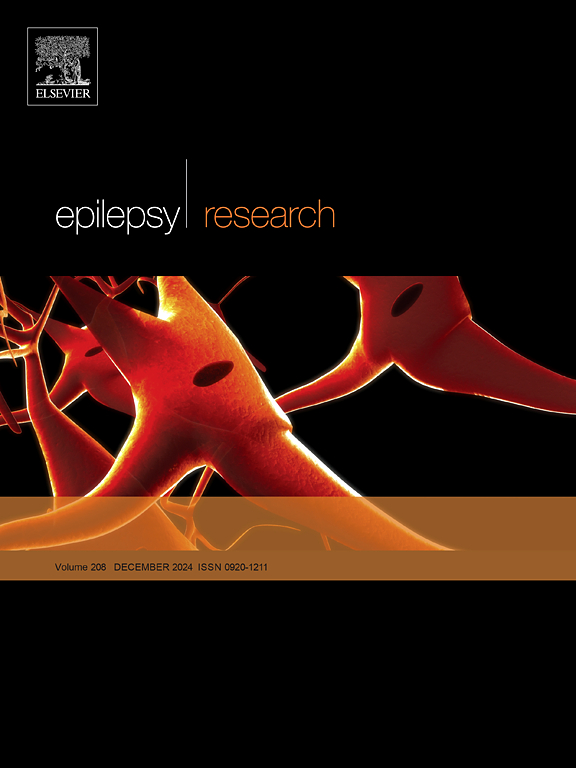4-苯基丁酸恢复GABA摄取,减轻SLC6A1和SLC6A11微缺失/3p-综合征的癫痫发作:从细胞模型到人类患者
IF 2
4区 医学
Q3 CLINICAL NEUROLOGY
引用次数: 0
摘要
编码SLC6A1的GABA转运体1 (GAT-1)和编码SLC6A11的GABA转运体3 (GAT-3)的单倍不足缺失与癫痫综合征有关。尽管它们意义重大,但这些缺失的影响尚未被描述。我们之前对SLC6A1错义突变的研究促进了Ravicti (NCT04937062)的临床试验,这是一种4-苯基丁酸酯(PBA)的甘油制剂,用于治疗耐药癫痫。我们观察到符合试验条件的SLC6A1突变患者和携带SLC6A1和SLC6A11缺失的3p综合征患者之间的表型重叠。这项研究描述了这些缺失对功能的影响,并评估了3p综合征患者是否能从这种治疗中受益的紧迫问题。方法染色体微阵列分析在两例3p综合征患儿中发现了SLC6A1和SLC6A11等位基因缺失。临床表型包括脑电图(EEG)记录和神经发育评估。采用3h标记的GABA摄取法和Western blotting对HEK293T细胞进行功能表征,比较单倍体不足和错义变异模型。结果单倍体GAT-1和GAT-3不足的情况下,GABA摄取和蛋白表达减少,与已知的SLC6A1错义变异相似。治疗后的脑电图显示,服用PBA后癫痫样放电中度减少,患者表现出改善的运动功能。然而,不同程度的认知障碍仍然存在。结论SLC6A1和SLC6A11基因多态性不足导致了3p-综合征的癫痫表型,这是首次对这些缺失对功能影响进行生化表征的研究。PBA治疗可能提供治疗益处,特别是在治疗癫痫发作和运动缺陷方面,尽管PBA对3p综合征患者的长期影响有待进一步探索。本文章由计算机程序翻译,如有差异,请以英文原文为准。
4-Phenylbutyrate restored GABA uptake, mitigated seizures in SLC6A1 and SLC6A11 microdeletions/3p- syndrome: From cellular models to human patients
Background
Haploinsufficient deletions of GABA transporter 1 (GAT-1)- encoding SLC6A1, and GABA transporter 3 (GAT-3)-encoding SLC6A11 are implicated in epileptic syndromes. Despite their significance, the impact of these deletions has not been characterized. Our previous work on SLC6A1 missense mutations prompted a clinical trial for Ravicti (NCT04937062), a glycerol formulation of 4-phenylbutyrate (PBA), for treatment-resistant epilepsy. We observed phenotypic overlap between trial-eligible SLC6A1 mutation patients and 3p- syndrome patients carrying deletions of SLC6A1 and SLC6A11. This study characterizes the functional impact of these deletions and assesses the urgent question of whether 3p- syndrome patients could benefit from this treatment.
Methods
Chromosomal microarray analysis identified a deletion affecting one allele of both SLC6A1 and SLC6A11 in two pediatric patients with 3p- syndrome. Clinical phenotyping included electroencephalogram (EEG) recordings and neurodevelopmental assessments. Functional characterization was conducted using 3H-labeled GABA uptake assays and Western blotting in HEK293T cells, comparing haploinsufficient and missense variant models.
Results
The haploinsufficient GAT-1 and GAT-3 conditions demonstrated reduced GABA uptake and protein expression, comparable to known SLC6A1 missense variants. Post-treatment EEGs showed a moderate reduction in epileptiform discharges following PBA administration, and patients exhibited improved motor function. However, varying degrees of cognitive impairments persisted.
Conclusions
Haploinsufficiency of SLC6A1 and SLC6A11 contributes to the epileptic phenotypes observed in 3p- syndrome, marking this as the first study to biochemically characterize the functional impact of these deletions. Treatment with PBA may provide therapeutic benefits, particularly for addressing seizures and motor deficits, though further exploration of PBA’s long-term effects in patients with 3p- syndrome is warranted.
求助全文
通过发布文献求助,成功后即可免费获取论文全文。
去求助
来源期刊

Epilepsy Research
医学-临床神经学
CiteScore
0.10
自引率
4.50%
发文量
143
审稿时长
62 days
期刊介绍:
Epilepsy Research provides for publication of high quality articles in both basic and clinical epilepsy research, with a special emphasis on translational research that ultimately relates to epilepsy as a human condition. The journal is intended to provide a forum for reporting the best and most rigorous epilepsy research from all disciplines ranging from biophysics and molecular biology to epidemiological and psychosocial research. As such the journal will publish original papers relevant to epilepsy from any scientific discipline and also studies of a multidisciplinary nature. Clinical and experimental research papers adopting fresh conceptual approaches to the study of epilepsy and its treatment are encouraged. The overriding criteria for publication are novelty, significant clinical or experimental relevance, and interest to a multidisciplinary audience in the broad arena of epilepsy. Review articles focused on any topic of epilepsy research will also be considered, but only if they present an exceptionally clear synthesis of current knowledge and future directions of a research area, based on a critical assessment of the available data or on hypotheses that are likely to stimulate more critical thinking and further advances in an area of epilepsy research.
 求助内容:
求助内容: 应助结果提醒方式:
应助结果提醒方式:


